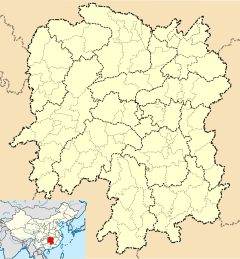Haihui Temple (Xiangtan)
| Haihui Temple | |
|---|---|
海会寺 | |
 | |
| Religion | |
| Affiliation | Buddhism |
| Sect | Chan Buddhism |
| Location | |
| Location | Yuhu District, Xiangtan, Hunan, China |
| Geographic coordinates | 27°51′35″N 112°54′38″E / 27.85972°N 112.91056°E |
| Architecture | |
| Style | Chinese architecture |
| Founder | Shi Puzhong |
| Date established | Yuan dynasty (1271–1368) |
| Materials | Bricks and cement |
Haihui Temple (simplified Chinese: 海会寺; traditional Chinese: 海會寺; pinyin: Hǎihuì Sì) is a Buddhist temple located in Yuhu District, Xiangtan, Hunan, China.[1][2] It is the site of Xiangtan Buddhist Association.
History
[edit]According to the Xiangtan County Annals, the temple's history stretches back to the Yuan dynasty (1271–1368), founded by Shi Puzhong (释璞忠).[1][2] It was rebuilt by Shi Zongyuan (释宗源) during the late Ming dynasty (1368–1644).[2] At that time, there are two branch temples under its administration, namely Daofeng Temple (道凤庵) and Juelin Temple (觉林寺).[2]
After the establishment of the Republic of China in 1912, a Buddhist school was set up in the temple.[2] In 1917, it became the Haihui School (海会小学).[2] The temple was restored by Shi Lingwu (释灵悟) in the 1930s.[2] Shi Jing'an, the Venerable Master of the Buddhist Association of the Republic of China, once lived here.[1][2]
After the founding of the Communist State, in 1952, due to no freedom of religious belief in China, two Buddhist nuns, Shi Liancang (释莲藏) and Shi Shaozong (释绍宗), forced to use the temple for producting cotton fabrics.[2] In 1962, it was designated as a provincial cultural relic preservation organ by the Hunan government.[2] During the ten-year Cultural Revolution, it was devastated by the Red Guards.[2] After the 3rd plenary session of the 11th Central Committee of the Chinese Communist Party, according to a policy of some religious freedom, the temple was refurbished by Shi Shaozong and was officially reopened to the public.[2] In 1995, Hunan government listed it as a "Key Buddhist Temple in Hunan Province".[1]
Architecture
[edit]Along the central axis are the Shanmen, Four Heavenly Kings Hall, Mahavira Hall.[1][2] There are over 10 halls and rooms on both sides, including Guanyin Hall, Buddhist Texts Library, Monastic Dining Hall, Monastic Reception Hall and Meditation Hall.[1][2]
Gallery
[edit]References
[edit]- ^ a b c d e f 湘潭海会寺 [Haihui Temple in Xiangtan]. fjhnw.com (in Chinese). 9 April 2016. Retrieved 6 July 2021.
- ^ a b c d e f g h i j k l m n 湘潭海会寺闹中取静 历经沧桑却屹立不倒 [The Haihui temple is a quiet place in the rustling and bustling city of Xiangtan, but it stands through many vicissitudes]. Sohu (in Chinese). 17 January 2017. Retrieved 6 July 2021.








